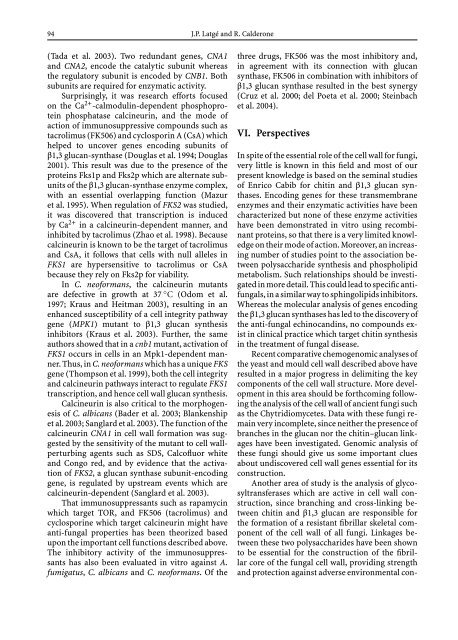Growth, Differentiation and Sexuality
Growth, Differentiation and Sexuality
Growth, Differentiation and Sexuality
Create successful ePaper yourself
Turn your PDF publications into a flip-book with our unique Google optimized e-Paper software.
94 J.P. Latgé <strong>and</strong> R. Calderone<br />
(Tada et al. 2003). Two redundant genes, CNA1<br />
<strong>and</strong> CNA2, encode the catalytic subunit whereas<br />
the regulatory subunit is encoded by CNB1. Both<br />
subunits are required for enzymatic activity.<br />
Surprisingly, it was research efforts focused<br />
on the Ca 2+ -calmodulin-dependent phosphoprotein<br />
phosphatase calcineurin, <strong>and</strong> the mode of<br />
action of immunosuppressive compounds such as<br />
tacrolimus (FK506) <strong>and</strong> cyclosporin A (CsA) which<br />
helped to uncover genes encoding subunits of<br />
β1,3 glucan-synthase (Douglas et al. 1994; Douglas<br />
2001). This result was due to the presence of the<br />
proteins Fks1p <strong>and</strong> Fks2p which are alternate subunits<br />
of the β1,3 glucan-synthase enzyme complex,<br />
with an essential overlapping function (Mazur<br />
et al. 1995). When regulation of FKS2 was studied,<br />
it was discovered that transcription is induced<br />
by Ca 2+ in a calcineurin-dependent manner, <strong>and</strong><br />
inhibited by tacrolimus (Zhao et al. 1998). Because<br />
calcineurin is known to be the target of tacrolimus<br />
<strong>and</strong> CsA, it follows that cells with null alleles in<br />
FKS1 are hypersensitive to tacrolimus or CsA<br />
because they rely on Fks2p for viability.<br />
In C. neoformans, the calcineurin mutants<br />
are defective in growth at 37 ◦ C (Odom et al.<br />
1997; Kraus <strong>and</strong> Heitman 2003), resulting in an<br />
enhanced susceptibility of a cell integrity pathway<br />
gene (MPK1) mutant to β1,3 glucan synthesis<br />
inhibitors (Kraus et al. 2003). Further, the same<br />
authors showed that in a cnb1 mutant, activation of<br />
FKS1 occurs in cells in an Mpk1-dependent manner.<br />
Thus, in C. neoformans which has a unique FKS<br />
gene (Thompson et al. 1999), both the cell integrity<br />
<strong>and</strong> calcineurin pathways interact to regulate FKS1<br />
transcription, <strong>and</strong> hence cell wall glucan synthesis.<br />
Calcineurin is also critical to the morphogenesis<br />
of C. albicans (Bader et al. 2003; Blankenship<br />
et al. 2003; Sanglard et al. 2003). The function of the<br />
calcineurin CNA1 in cell wall formation was suggested<br />
by the sensitivity of the mutant to cell wallperturbing<br />
agents such as SDS, Calcofluor white<br />
<strong>and</strong> Congo red, <strong>and</strong> by evidence that the activation<br />
of FKS2, a glucan synthase subunit-encoding<br />
gene, is regulated by upstream events which are<br />
calcineurin-dependent (Sanglard et al. 2003).<br />
That immunosuppressants such as rapamycin<br />
which target TOR, <strong>and</strong> FK506 (tacrolimus) <strong>and</strong><br />
cyclosporine which target calcineurin might have<br />
anti-fungal properties has been theorized based<br />
upon the important cell functions described above.<br />
The inhibitory activity of the immunosuppressants<br />
has also been evaluated in vitro against A.<br />
fumigatus, C. albicans <strong>and</strong> C. neoformans. Ofthe<br />
three drugs, FK506 was the most inhibitory <strong>and</strong>,<br />
in agreement with its connection with glucan<br />
synthase, FK506 in combination with inhibitors of<br />
β1,3glucansynthaseresultedinthebestsynergy<br />
(Cruz et al. 2000; del Poeta et al. 2000; Steinbach<br />
et al. 2004).<br />
VI. Perspectives<br />
In spite of the essential role of the cell wall for fungi,<br />
very little is known in this field <strong>and</strong> most of our<br />
present knowledge is based on the seminal studies<br />
of Enrico Cabib for chitin <strong>and</strong> β1,3 glucan synthases.<br />
Encoding genes for these transmembrane<br />
enzymes <strong>and</strong> their enzymatic activities have been<br />
characterized but none of these enzyme activities<br />
have been demonstrated in vitro using recombinant<br />
proteins, so that there is a very limited knowledge<br />
on their mode of action. Moreover, an increasing<br />
number of studies point to the association between<br />
polysaccharide synthesis <strong>and</strong> phospholipid<br />
metabolism. Such relationships should be investigatedinmoredetail.Thiscouldleadtospecificantifungals,<br />
in a similar way to sphingolipids inhibitors.<br />
Whereas the molecular analysis of genes encoding<br />
the β1,3 glucan synthases has led to the discovery of<br />
the anti-fungal echinoc<strong>and</strong>ins, no compounds exist<br />
in clinical practice which target chitin synthesis<br />
in the treatment of fungal disease.<br />
Recent comparative chemogenomic analyses of<br />
the yeast <strong>and</strong> mould cell wall described above have<br />
resulted in a major progress in delimiting the key<br />
components of the cell wall structure. More development<br />
in this area should be forthcoming following<br />
the analysis of the cell wall of ancient fungi such<br />
as the Chytridiomycetes. Data with these fungi remain<br />
very incomplete, since neither the presence of<br />
branches in the glucan nor the chitin–glucan linkages<br />
have been investigated. Genomic analysis of<br />
these fungi should give us some important clues<br />
aboutundiscoveredcellwallgenesessentialforits<br />
construction.<br />
Another area of study is the analysis of glycosyltransferases<br />
which are active in cell wall construction,<br />
since branching <strong>and</strong> cross-linking between<br />
chitin <strong>and</strong> β1,3 glucan are responsible for<br />
the formation of a resistant fibrillar skeletal component<br />
of the cell wall of all fungi. Linkages between<br />
these two polysaccharides have been shown<br />
to be essential for the construction of the fibrillar<br />
core of the fungal cell wall, providing strength<br />
<strong>and</strong> protection against adverse environmental con-

















